There is a worldwide sweep of retired players who reached the peak of their powers from the late noughties to the mid-2010s, moving into managerial slots.
In recent months, Carlos Tevez took the leap into management, becoming the head coach of Rosario Central, while Ruud van Nistelrooy was handed his first job in the men’s game, taking control of Eredivisie giants PSV Eindhoven.
Furthermore, Michael Carrick has also accepted a permanent job as the boss of Middlesbrough in the EFL Championship.
Italy has had its own upsurge of national heroes taking management roles across the top two divisions.
From Andrea Pirlo’s appointment at Juventus in 2020 to Thiago Motta’s spells in charge of Genoa, Spezia and now Bologna, the next generation of Italian legends-cum coaches is well and truly in the offing.
Now, another World Cup-winning player has been given a chance as a head coach.
AS Roma legend Daniele De Rossi has been chosen to succeed the experienced Roberto Venturato in the dugout for Serie B side SPAL.
So far, the Biancazzurri have seen mixed results during the 39-year-old’s brief tenure, winning one, drawing one, and losing one.
However, encouragingly, they have conceded just one goal and scored five in three games.
This tactical analysis
will examinethe tactics that De Rossi coaching style has integrated at the Stadio Paolo Mazza in his first few weeks at the helm.
Daniele De Rossi Formations
One of the primary aspects of SPAL’s tactical set-up that De Rossi has tried to reconstruct is their base formation.
Under Venturato, to very little success, the Biancazzurri set up mainly in a 4-3-1-2 shape, or a 4-4-2 diamond depending on how deep the number ‘6’ played in midfield.
There were even times when the 59-year-old deployed a more conventional 4-3-3, using the wide strikers as wingers while replacing the number ‘10’ with an orthodox centre-forward.
However, with merely three wins in nine matches, including just two in the league, it was clear that something needed to change tactically.
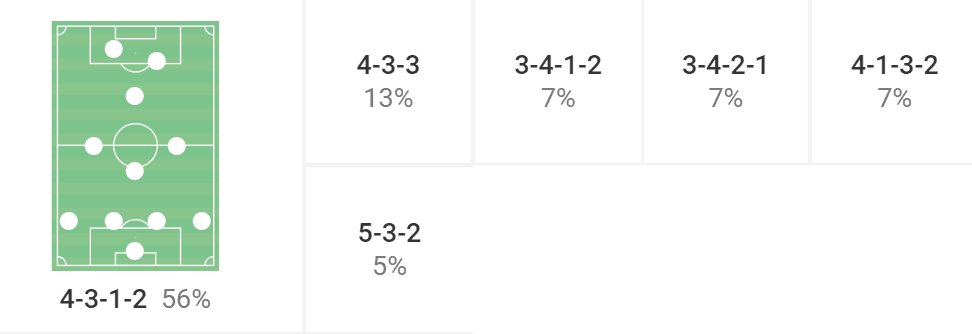
This visual displays all of the formations that SPAL have used this season in all competitions.
The dominant shape is still Venturato’s 4-3-1-2 as well as his 4-3-3 but De Rossi has vastly tweaked the structure on the field.
Under the World Cup winner, the Serie B side are now setting up in a 3-4-2-1 for the most part while also utilising a 3-5-2 depending on the opposition and how compact they need to be in the central areas.
Of course, both systems drop into a 5-3-2/5-4-1 when in a low block state, providing the team with an extra man at the back.
The change to the back three has undoubtedly brought impressive performances, especially from a defensive standpoint, but now let’s take a look at exactly how SPAL operate within De Rossi’s system.
Daniele De Rossi Tactics – Building up through the pivot
The build-up phase is arguably the most common aspect of a team’s overall gameplan that is analysed the most due to the high volume of different variations that are possible when playing out from the goalkeeper.
Using a back three in particular offers quite a lot of variety in this area of the pitch for coaches and players due to the positioning of the central defenders.
Some managers, such as Jose Mourinho, prefer to push one of the centre-backs higher alongside the pivot players in order to provide more options behind the opposition’s first line of pressure.
Nonetheless, De Rossi has adopted Antonio Conte’s blueprint of moving one of the wingbacks into an advanced position.
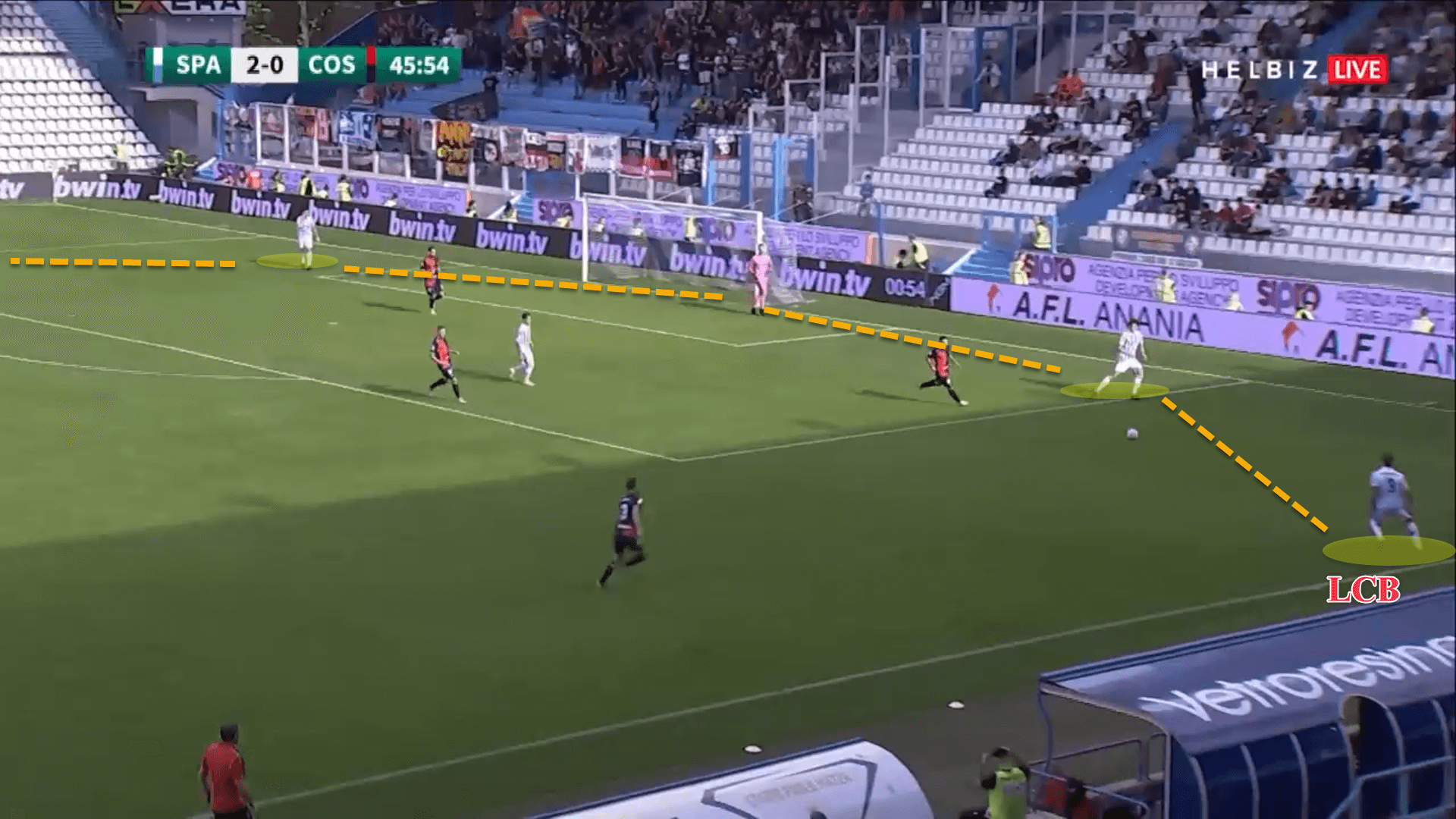
Essentially, the new manager instructs one of his wide centre-backs to move out to the typical fullback area on the flanks and become an auxiliary right or left-back while SPAL is in the build-up phase.
Meanwhile, the wingback on the same side moves well up the pitch as a winger, helping to support the forward line in case the ball is played long.
The team is tasked with winning the second ball.
When trying to play through their opponent’s pressure, De Rossi wants his players to reach higher areas through the central spaces, building up through the pivot.
Of course, this requires a high level of technical and spatial competence from the man tasked with operating as the single pivot, which is why full Italy international Salvatore Esposito performs this role for De Rossi.
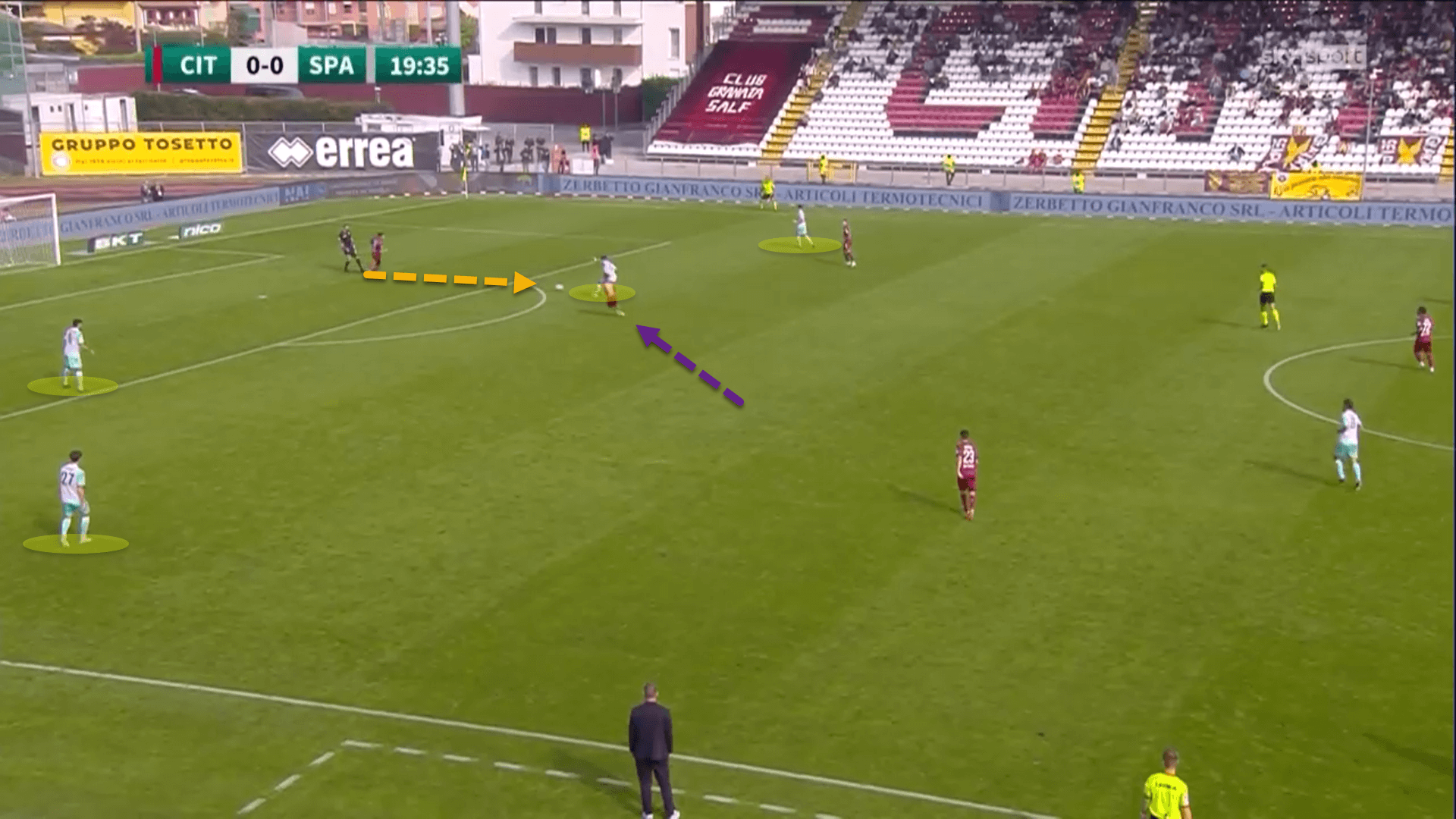
As shown in this image, Esposito is excellent with the ball at his feet and can escape pressure by receiving the ball on the half-turn and moving forward.
In the previous screenshot, the ball is coming toward the 22-year-old with his back turned to the goal.
Esposito scans over his shoulder to see his marker rushing from behind to close him down.
Not shying away from the danger, the youngster turns his body away from the defender and receives it on the back foot, bypassing the opposition’s initial pressing.
Looking at Esposito’s pass map from the manager’s debut against Cittadella, it is evident that De Rossi had instructed the young midfielder to try and make as many central passes as possible through the lines, progressing play for SPAL.
Salvatore Esposito Pass Map

Building up through the pivot is a bold tactic, especially for a team that does not possess world-class talents among their ranks.
Teams floating around the lower divisions of any country tend to play more out on the flanks and use combination play to beat the press.
It is risky for De Rossi and SPAL
, but when it pays off, the Biancazzurri can easily carve teams open.One way they look to do so is by using third-man passes, which involve creating angles for one another to facilitate clean and eye-watering ball progression.
During these moments, SPAL’s style resembles that of a team coached by Roberto De Zerbi.
They play short passes to lure the opposition’s midfield to press higher before upping the tempo to go in behind.
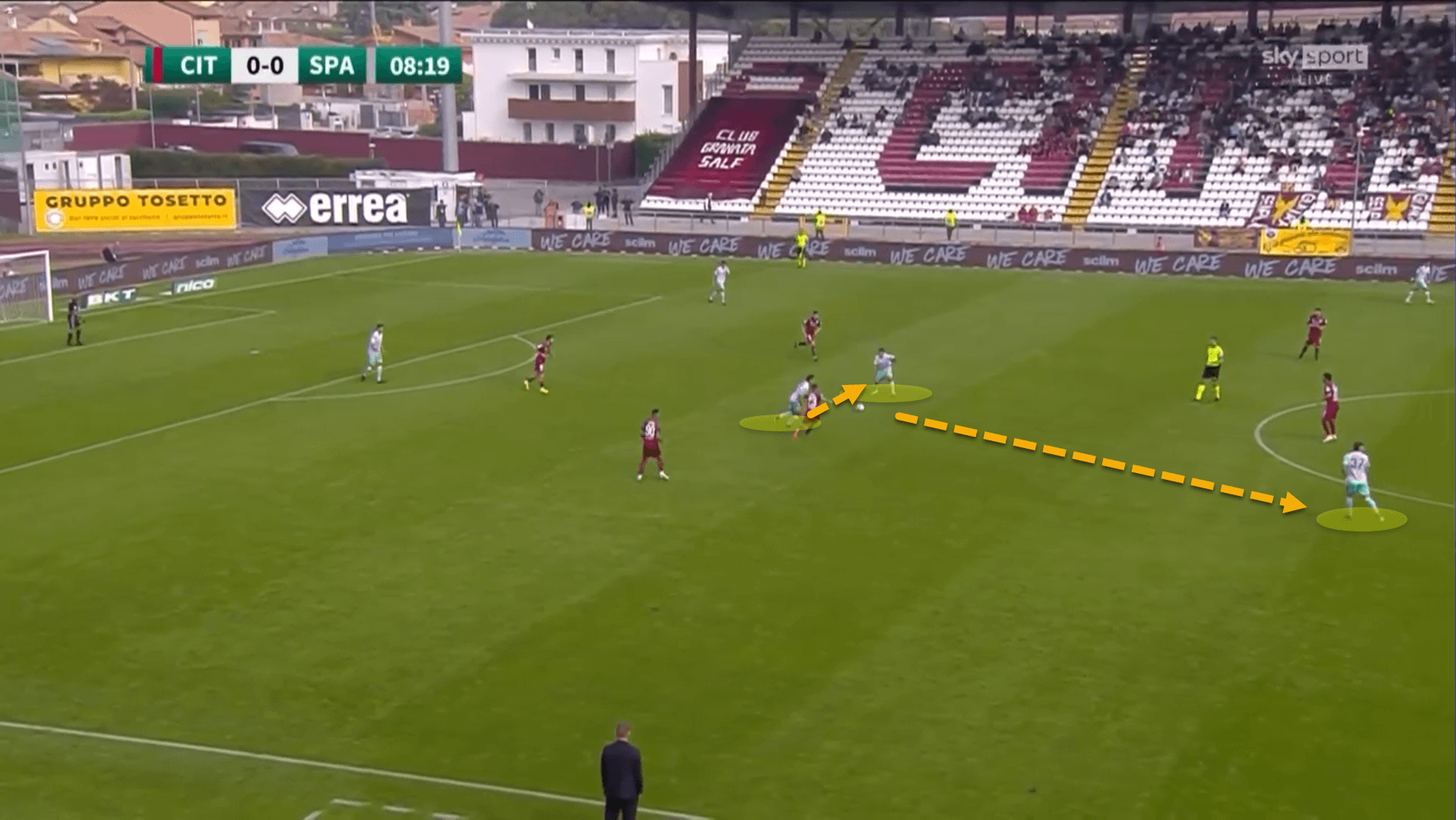
From there, the more advanced players can drive forward and have a free run at the backline, which is an excellent way to create opportunities by playing riskily through the pivot.
This is an area of SPAL’s game that the team are getting used to with each passing match.
On De Rossi’s debut, the Italian minnows had 18 positional attacks but failed to register a single shot.
During his second bout in charge, SPAL mustered one from 21.
However, in his most recent outing, a 5-0 thrashing of Cosenza, SPAL increased this poor record to 7 shots from 21 positional attacks, meaning they are getting more comfortable with De Rossi’s philosophy as time wears on.
Man-oriented pressing De Rossi’s tactical nous
De Rossi has proven himself to be a ‘progressive’ coach during his first few matches in the dugout.
This term seems quite disrespectful, given that there is no right way to play football, but it does imply that the team plays out from the back and also presses high up the pitch, as has become trendy in the modern game.
Nonetheless, there is still a tinge of conservatism at the core of the former midfielder’s philosophy which is evident from how SPAL have looked out of possession during the 39-year-old’s tenure thus far.
Quite often, especially when the opposition is playing out from their own penalty area, SPAL will drop off into a compact mid-block and not look to engage higher up the pitch.
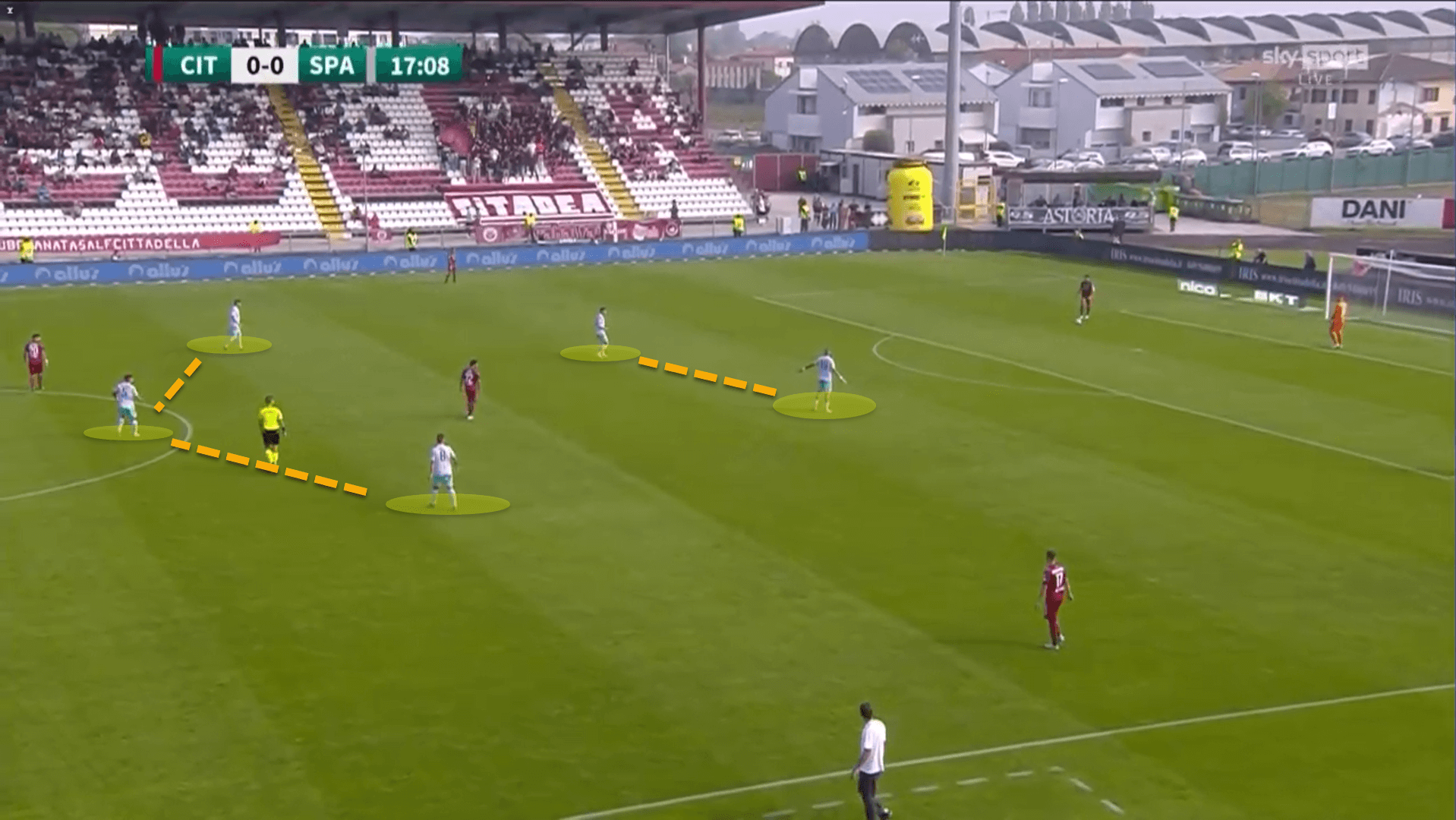
Here, Cittadella is passing out from the goalkeeper during the build-up phase, but SPAL is not interested and instead reverts into a 5-3-2 medium-to-low-level block, compacting space between the lines.
The plan worked for the Biancazzurri, who kept a clean sheet in this bout.
Cittadella found it incredibly hard to find any space inside SPAL’s sturdy defensive structure.
But still, in the next game against Genoa in the Coppa Italia, De Rossi took an entirely different approach.
SPAL pressed high up the pitch, doing so in a man-oriented fashion within a slightly tweaked 3-4-1-2 shape.
Throughout Italian football, there is a renaissance of man-to-man pressing, spearheaded by Gian Piero Gasperini, the pioneer of the rejuvenation.
Most of the adaptations have come from the disciples of the experienced Atalanta coach.
Ivan Jurić at Torino, Salvatore Bocchetti at Hellas Verona, and Raffaele Palladino all played under Gasperini at Genoa and have followed the 64-year-old’s pressing methods.
Regardless, some coaches outside of Gasperini’s bubble have also begun using a more man-oriented approach when pressing in the final third, such as Stefano Pioli.
De Rossi, who never played under Gasperini throughout his illustrious career, also uses this formula at the Stadio Paolo Mazza.
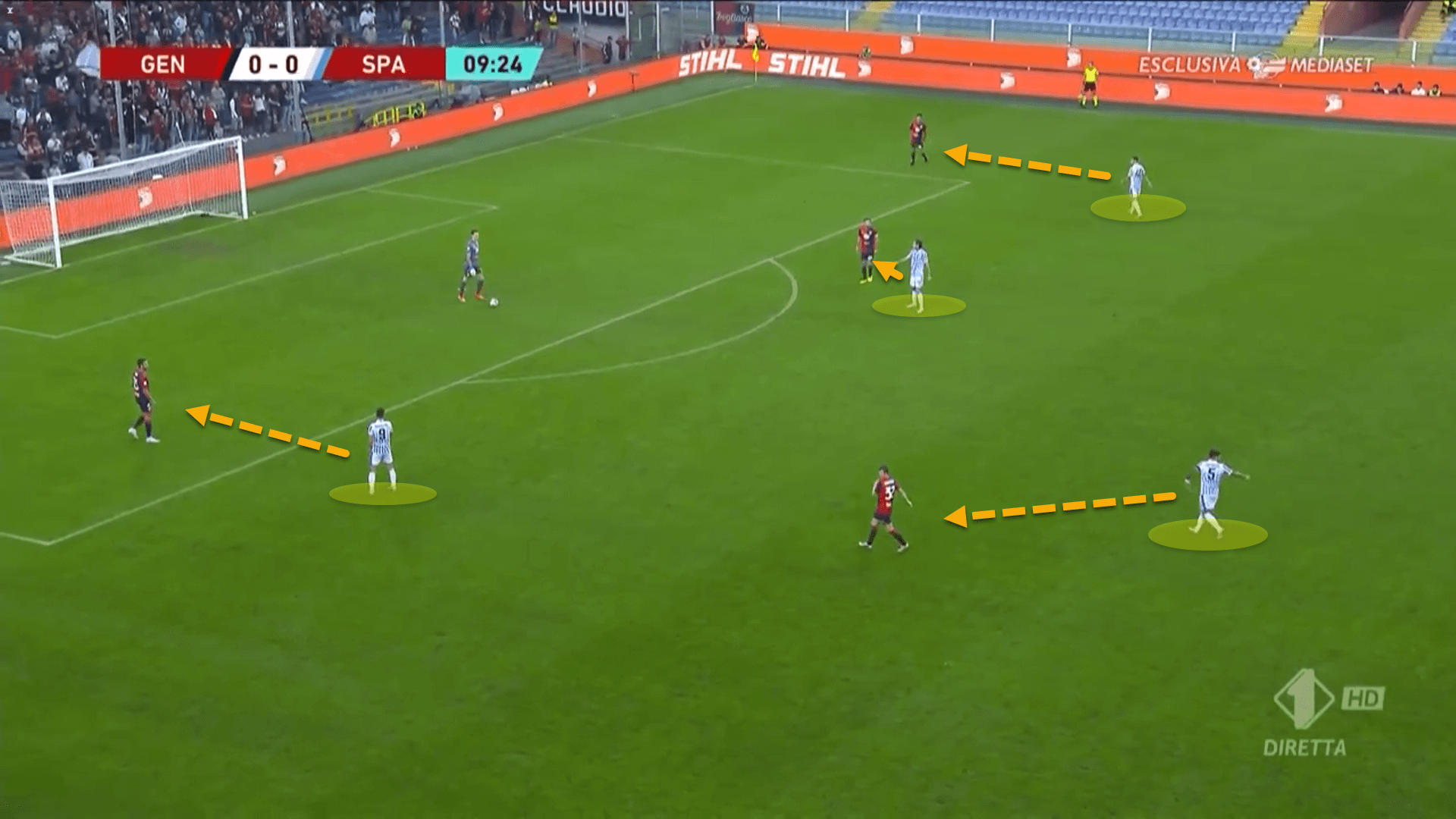
This was predominantly noticeable in the match against Genoa when SPAL outmatched the hosts man-for-man in the final third of their 5-2-1-2 high block.
Genoa, under the tutelage of Alexander Blessin, was set up in a 4-2-3-1, and so each player in the midfield and forward line for SPAL was tasked with marking an opposition player, including the split strikers on Genoa’s central defenders while the wingbacks marked Blessin’s fullbacks.
However, problems began to emerge for De Rossi from the get-go, and the inexperienced coach really showed his tactical nous for the first time.
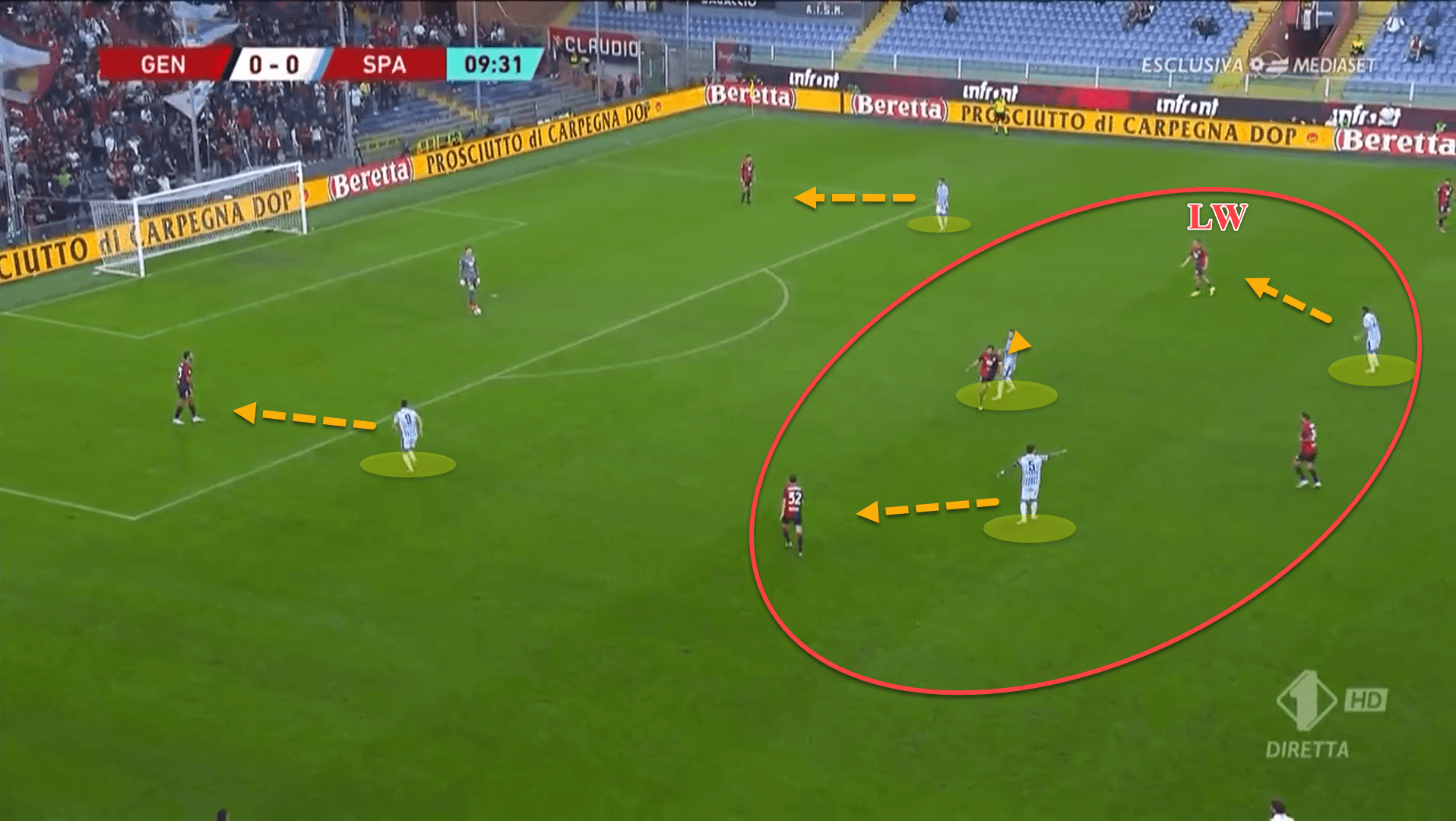
SPAL was outnumbered in the middle of the park during the high block phase.
Blessin instructed one of his wingers within the 4-2-3-1 to invert and add an extra body to overload the centre of the park, which always gave Genoa a free man to play to.
This caused SPAL’s pressing scheme to be carved open on numerous occasions within the opening fifteen minutes of play.
After realising the issue, De Rossi quickly changed the team’s setup.
SPAL began dropping off and was more hesitant to press than in the opening quarter of an hour.
The manager instructed his players to sit deeper and allow Genoa to have possession for the most part, changing the shape to a 5-3-2 instead of a 5-2-1-2 out of possession.
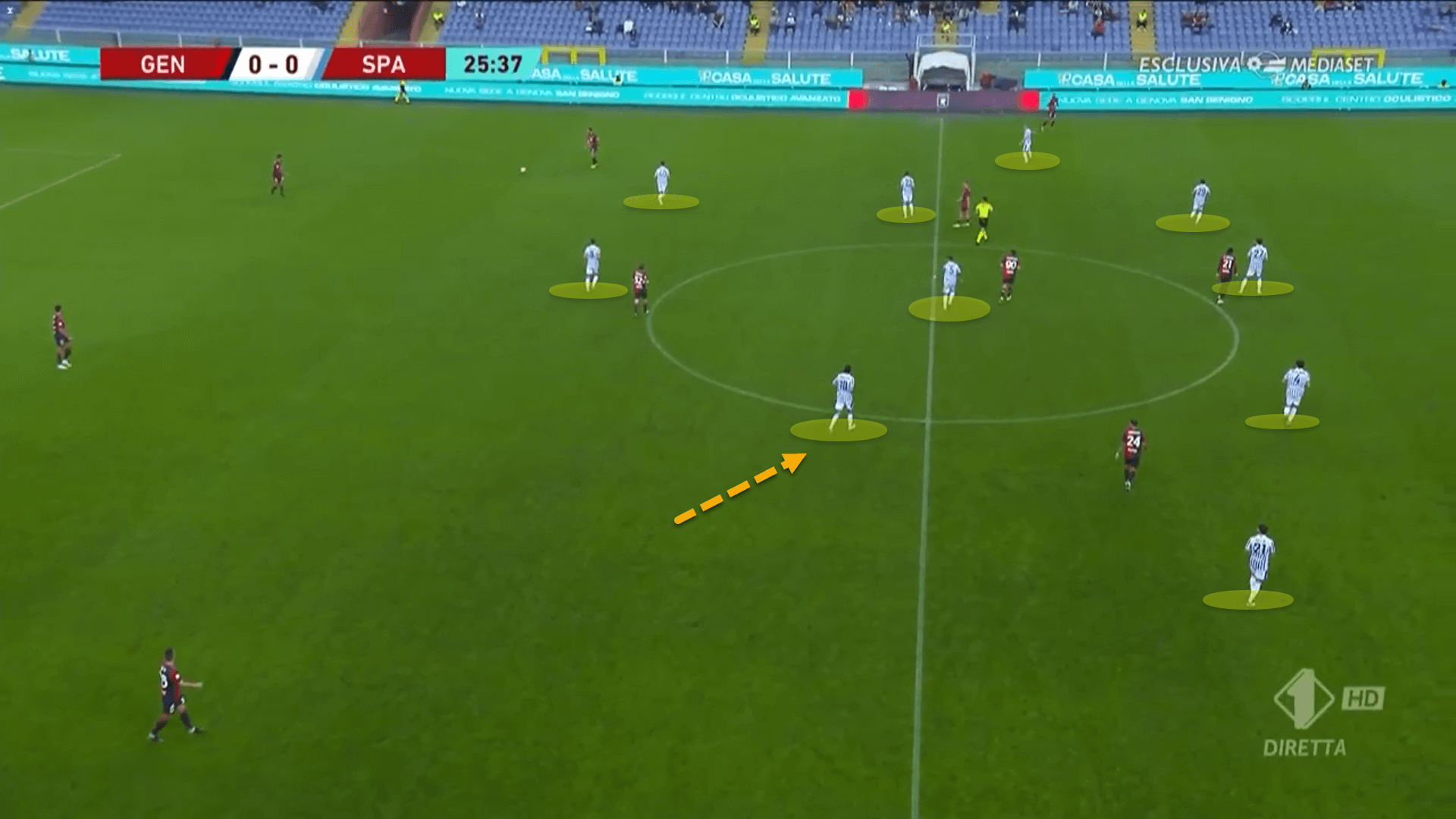
In time, the Biancazzurri may adapt to pressing in a man-oriented fashion, but De Rossi showed a lack of stubbornness to make his team much more secure defensively.
Low block defending
SPAL
has conceded just once since De Rossi took over.So far, the side has averaged 0.99 xGA (expected goals against) per game under the Italian legend, but in Serie B, this has dropped to merely 0.53.
One reason for their excellent defensive record in De Rossi’s early days is the mean low block the head coach deployed.
As discussed, SPAL hasn’t quite mastered pressing just yet but looks far more adept and confident when sitting in a compact, low block, denying the opposition space through the central areas and behind the backline.
The lines of the block are always minuscule horizontally in order to discourage the opposition from trying to play into this area, whether this is by sitting in a 5-2-3 shape or a more centrally congested 5-3-2.
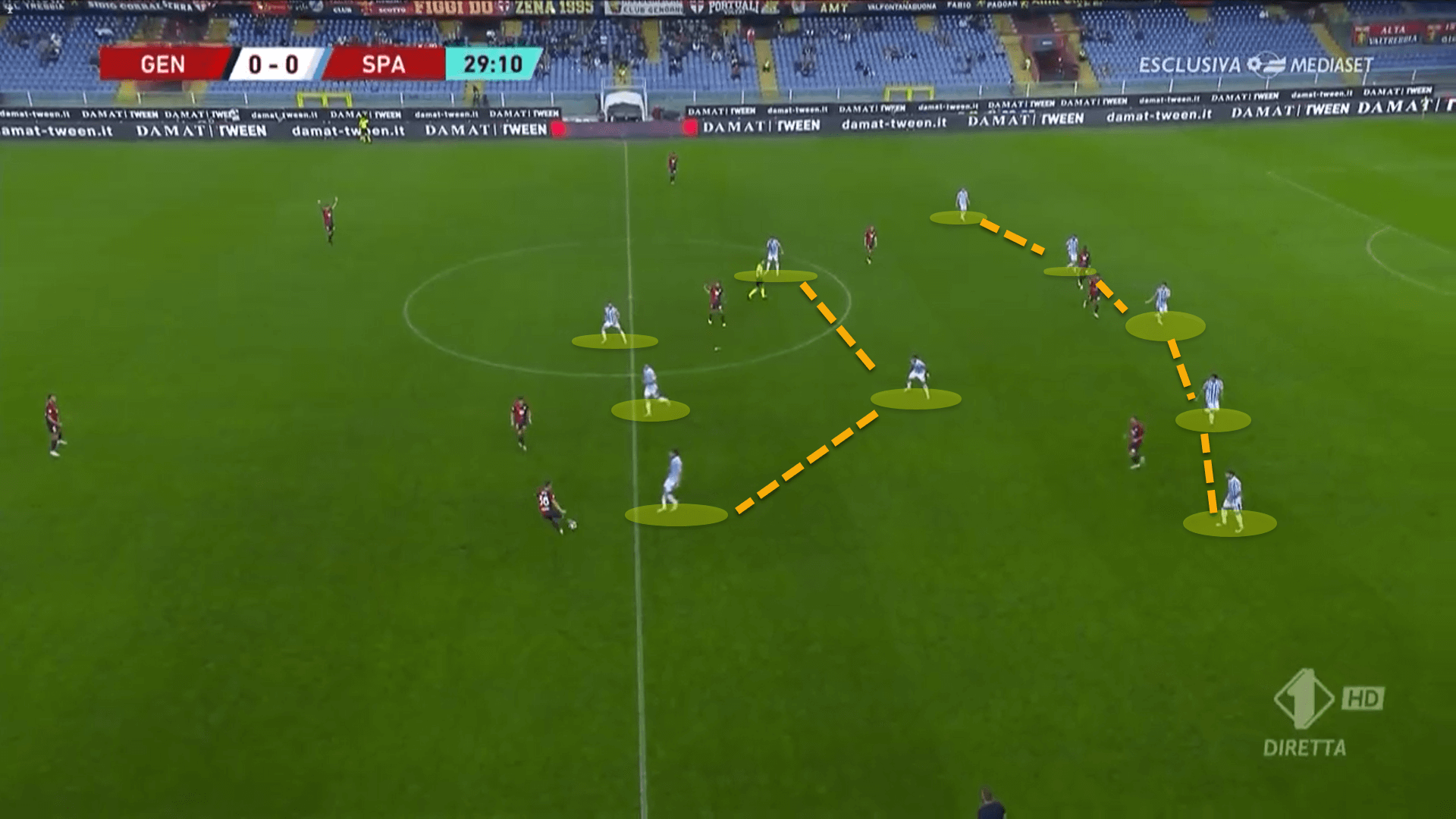
One of the most tactically intriguing components of SPAL’s principles during the low block phase is that De Rossi wants his centre-backs to be aggressive if the ball does actually reach the space between the lines.
Using a back five facilitates this slightly better than a back four would, given that, when a central defender steps out, there are four remaining in the defensive line to squeeze closer together and plug the gaps left by the aggressive centre-back.
Nevertheless, there are still times when this tactic can be risky for a team, especially if the centre-back who is stepping out of position fails to close down the ball receiver correctly.
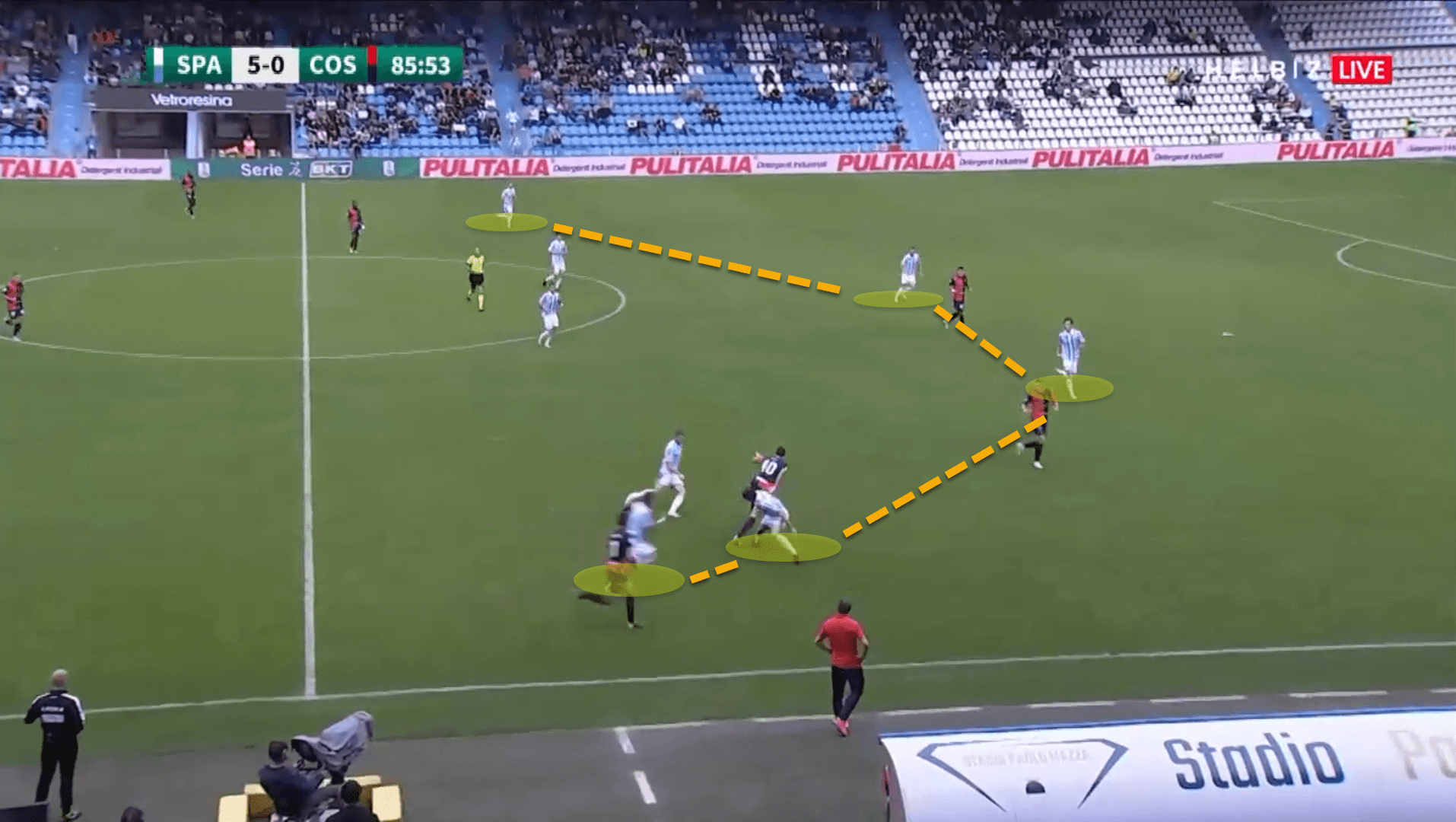
For instance, here, the left of the three central defenders jumped the ball carrier in an attempt to prevent them from turning and playing forward.
However, his pressure from behind failed, and the attacker turned the centre-back with ease, leaving a vast gap down this side.
Overall, teams have found it quite difficult to break down SPAL’s low block since De Rossi took over.
As they are unable to penetrate through the Biancazzurri on the deck, most of the team’s opponents aim to play it around the corner into the channels, where they try to isolate the three centre-backs.
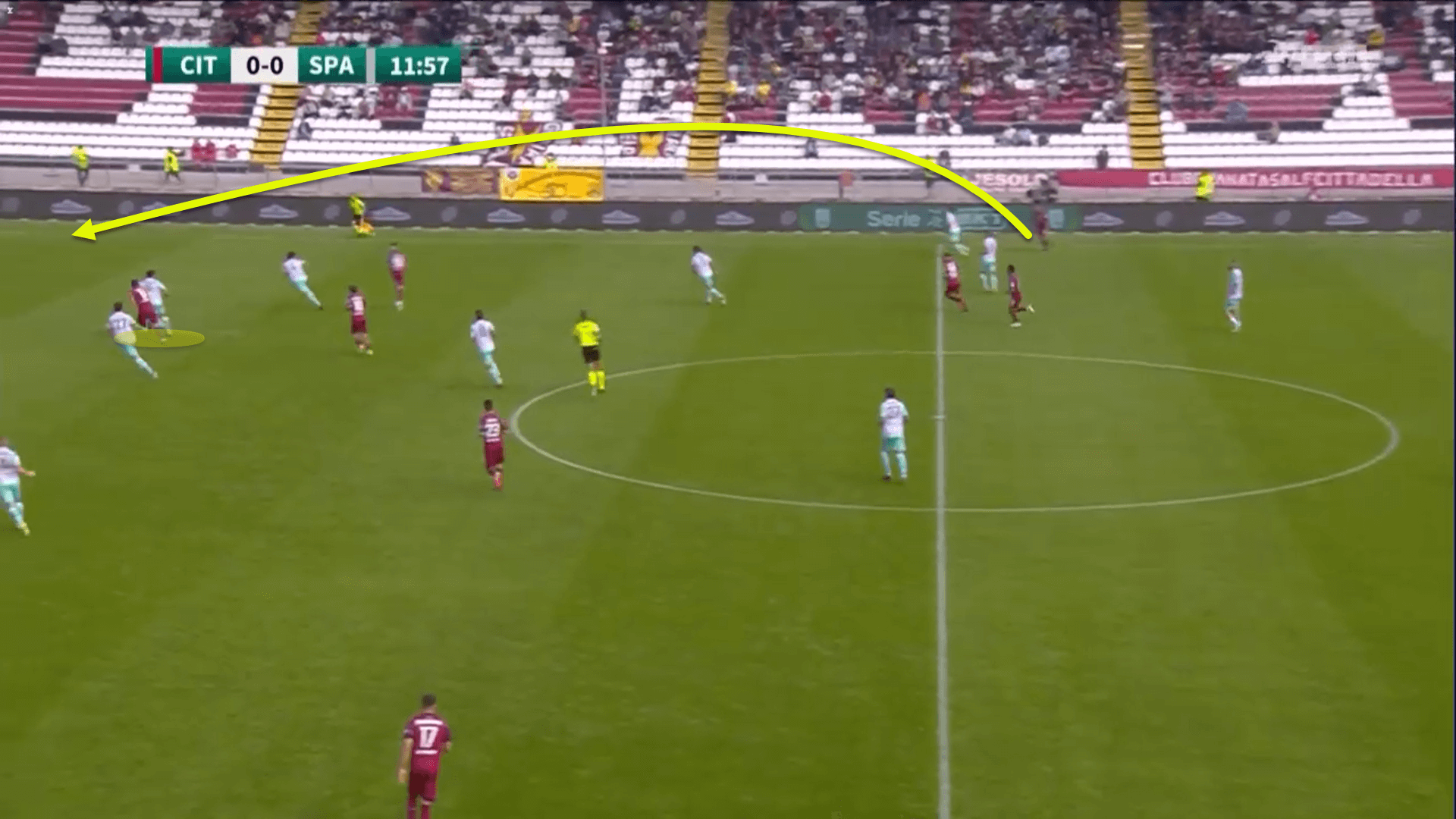
Unfortunately, for their opposition, these channel balls have proven ineffective so far, as the centre-backs have been unable to deal with the 1v1 situations they have found themselves in.
However, one area that needs to be worked on for SPAL during the low block phase is how effectively the midfield covers the backline.
There are times when the centre-backs or the wingbacks are dragged across and out of their natural position, leaving holes to be exploited within the backline.
However, the midfield doesn’t plug these gaps, leaving a weakness in the defensive structure.
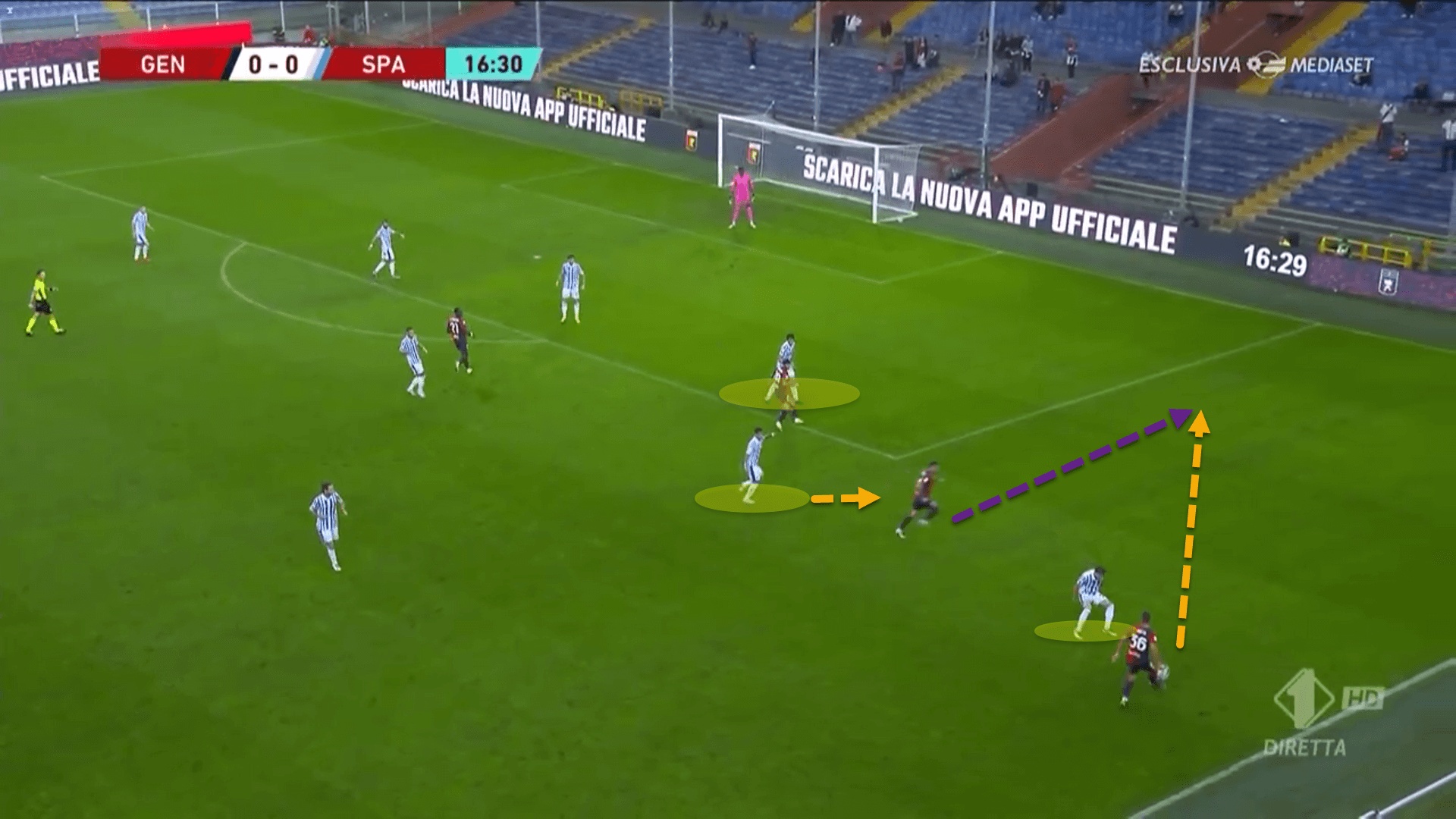
In this image, the SPAL left wingback has had to step across to apply pressure to his opposite number, stretching the distance between himself and the left centre-back.
Seeing the space, the Genoa winger makes a run in behind but is not tracked by SPAL’s midfielder, who should have scanned the situation and noticed the danger before intervening.
Conclusion
Going forward, De Rossi really needs to dig his heels in and get to work on the training pitch with this SPAL side.
With the exception of the 5-0 trouncing over a lacklustre Cosenza, the Biancazzurri have looked toothless under his reign and rather lost with their final third play.
However, during build-up and in the defensive phases, SPAL has looked the most tactically astute so far since the World Cup winner took over.
With a bit more time in charge of the Serie B team, De Rossi may be able to make a late attempt to climb into the playoff spots by the end of the season.






Comments